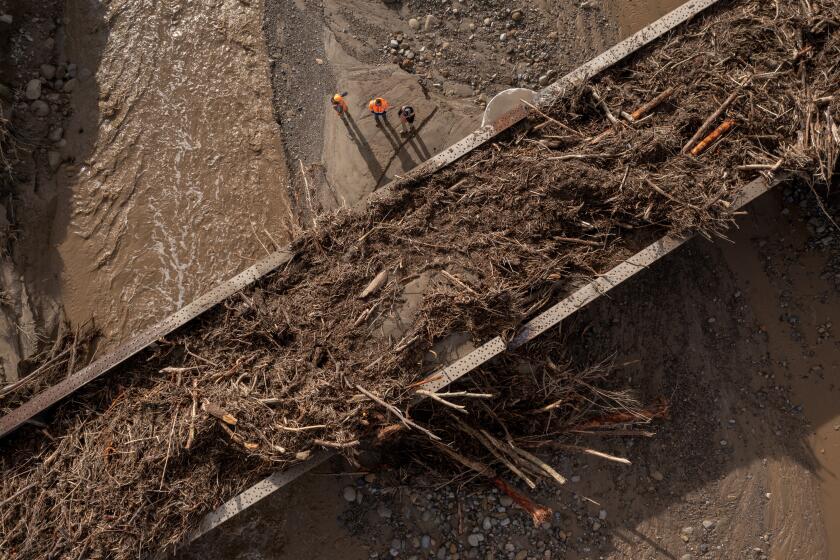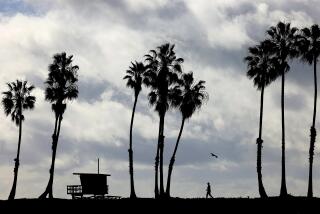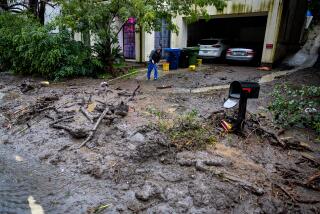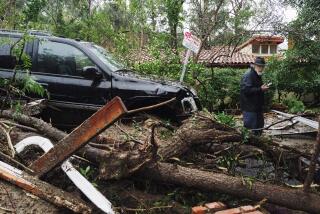Storm leaves California coastal towns badly damaged -- with more danger on the way
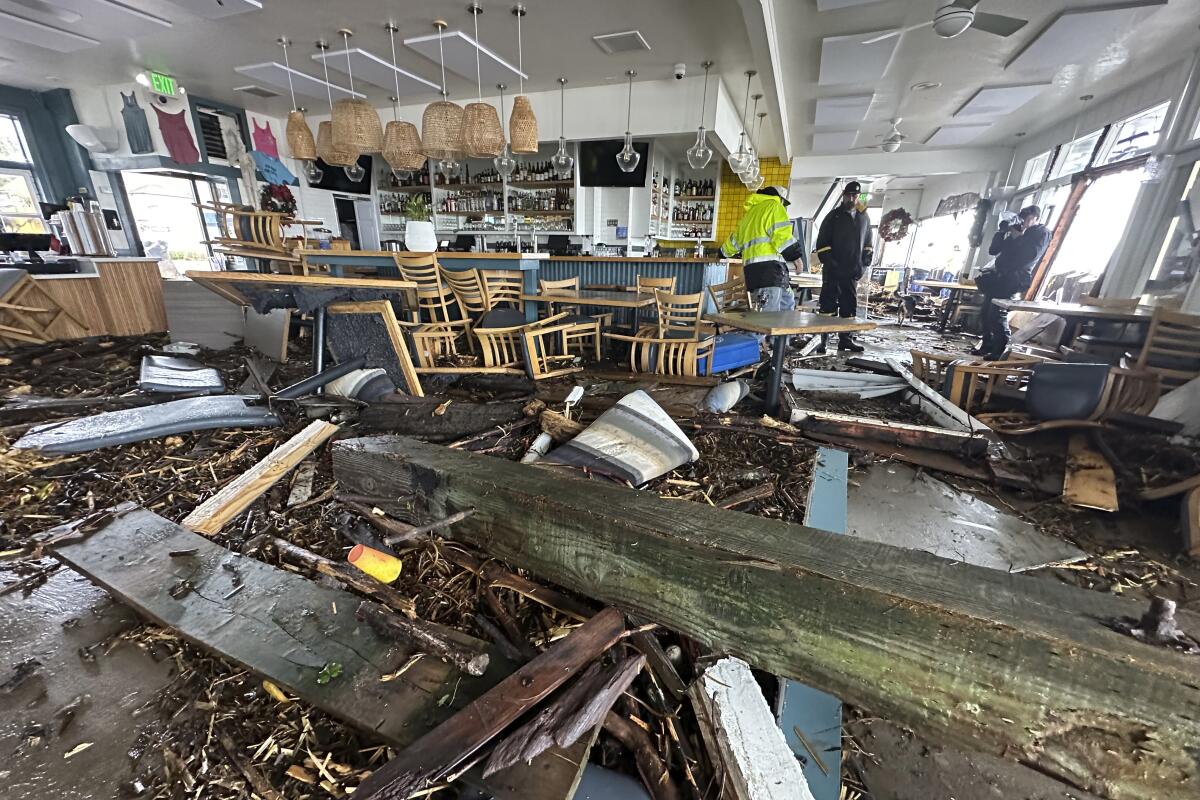
SANTA CRUZ — The latest in a series of atmospheric river storms pummeled Northern California on Thursday, toppling trees, battering the coastline and swelling rivers and streams into furious torrents as residents braced for more intense weather set to arrive in the near future.
Storms over the last week have killed at least six people, including three whose bodies were found in or near submerged cars after a levee broke near Sacramento. A toddler was killed when a tree crashed into a residence in Sonoma County.
While many parts of Northern California escaped major damage, some coastal areas were swamped by high surf and flooding that left beaches in shambles. People living near the Russian River remain on edge, given the chance that waters could rise to dangerous levels over the next few days.
The powerful storm that knocked out power, toppled trees — including one that killed a toddler — and flooded homes along the coast in Santa Cruz continued its march through the region.
But the biggest concern remains the effect more stormy weather will have across the already inundated region.
“It’s going to remain wet and unsettled for the coming days,” said Scott Rowe, a lead meteorologist with the National Weather Service in Sacramento. “Through the weekend and next week we’re expecting at least two, three, possibly even more storms to be impacting Northern California, so it’s something we’re keeping a close eye on.”
After a short reprieve Friday, a moderate storm will blow back into the Bay Area over the weekend, renewing the risk of flooding. Forecasters are more worried about a “much stronger” storm that will hit Monday and Tuesday. During that event, “widespread and potentially significant flooding” is expected, as are gusty winds and landslides, according to the weather service. And more storms are still possible, with additional chances of rain late next week.
That one-two punch will only add to what’s been a soaking start to the year. Downtown San Francisco has already recorded its wettest 10-day period since 1871.
Thursday’s storm dumped 2 to 3 inches of rain across the San Francisco Bay Area, and isolated showers were expected to add to that total through the evening. Roughly an inch of rain fell over a 24-hour period across much of the Sacramento area as of early Thursday, less than forecasters initially expected.
But, for some, the effects were no less profound. As of Thursday evening, about 10 of 30 beds were occupied at an evacuation shelter set up at the Barbara Morse Wackford Community Center in Elk Grove.
Terry Sanford, the shelter’s acting manager, said the clients were a mix of unsheltered people and those who saw their homes flooded.
“A lot of them are just worried about finding a safe spot, because when there’s flooding, even if you’re homeless, you lose your home,” she said. “We had one couple who lost their tent, their bikes, everything. They have nothing.”
The death of the toddler was one of at least two attributed to the storm that swept through Northern California.
Sanford said that the electricity at the shelter briefly went out Wednesday night and that she’s concerned about the upcoming storms over the weekend and next week.
“We can’t take any more water,” she said. “Everything’s saturated. It has to run somewhere.”
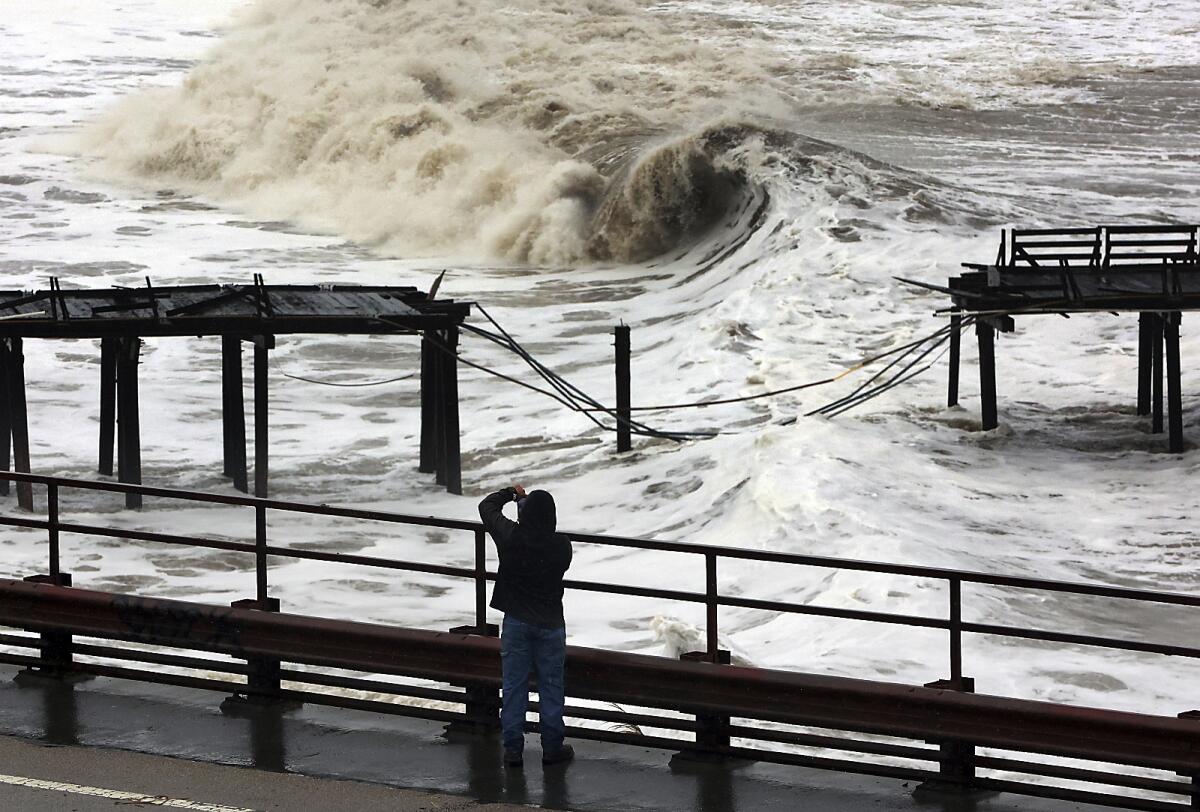
Santa Cruz County
One of the areas hardest hit by this latest storm was the Santa Cruz County coast, where high tides and giant waves destroyed sections of the pier in the seaside town of Capitola and another in Seacliff. The Santa Cruz Wharf was evacuated Thursday morning as waves reaching up to 20 feet buffeted the structure and officials warned spectators to seek shelter.
When Emma Simpkins, 23, an employee at the Picnic Basket near the wharf, arrived at the restaurant with her co-worker around 6:30 a.m., waves were breaking all the way up to the sidewalk.
In her five years in Santa Cruz, Simpkins said she’s never seen waves as large as the ones that pummeled the shore Thursday.
“I was here for the tsunami a few months ago, and even then it wasn’t this bad,” she said.
Down at the Boardwalk, logs and debris were pushed up to the fence line, just below the amusement park platform — making the beach seem more Olympic Peninsula in Washington state than California surf haven.
At the base of the San Lorenzo River, huge swells carried surfers upriver, below the railroad trestle and toward downtown.
“I’ve never seen anything like this,” said Andrea Prost, who lives in Scotts Valley but drove to the coast with her dog, Shelby, to check out the scene.
The powerful storm that knocked out power, toppled trees — including one that killed a toddler — and flooded homes along the coast in Santa Cruz continued its march through the region.
In Capitola, high tides and massive waves inundated businesses with water, prompting officials to evacuate thousands of residents. Police Chief Andy Dally said during a news conference that the flooding was triggered by a 5.6-foot high tide combined with a swell and rain runoff from the storm.
“Businesses sustained significant damage down in the Village,” he said. The beach-adjacent Capitola Village includes shops and restaurants.
Videos of the scene show torrents of water surging into seaside homes and businesses that had been boarded up in advance of the storm.
Onlookers along Cliff Drive gasped and pointed at the wreckage below: The pier, broken in two, and the damaged restaurants along the beach.
Sonoma County
To the north, roads across Sonoma County were blocked by downed trees, while de-energized power lines knocked loose by tumbling branches swung above darkened homes and businesses.
“Jiminy Christmas, I’ve never seen the winds so strong,” said Richard Cappell, 68, who lives on a ridge above the town of Occidental. He stood on his front porch Thursday, the hum of a generator almost drowning out the sound of the rain.
Down the hill in Occidental, the Altamont General Store was filled with people who had come in to get warm and use the available electricity to charge their phones and other electronics.
Resident Susan Gray said she heard some people are expected to be out for up to two weeks.
“I expect to lose power every year,” she said. “It’s been a while since we’ve [lost it] for this long.”
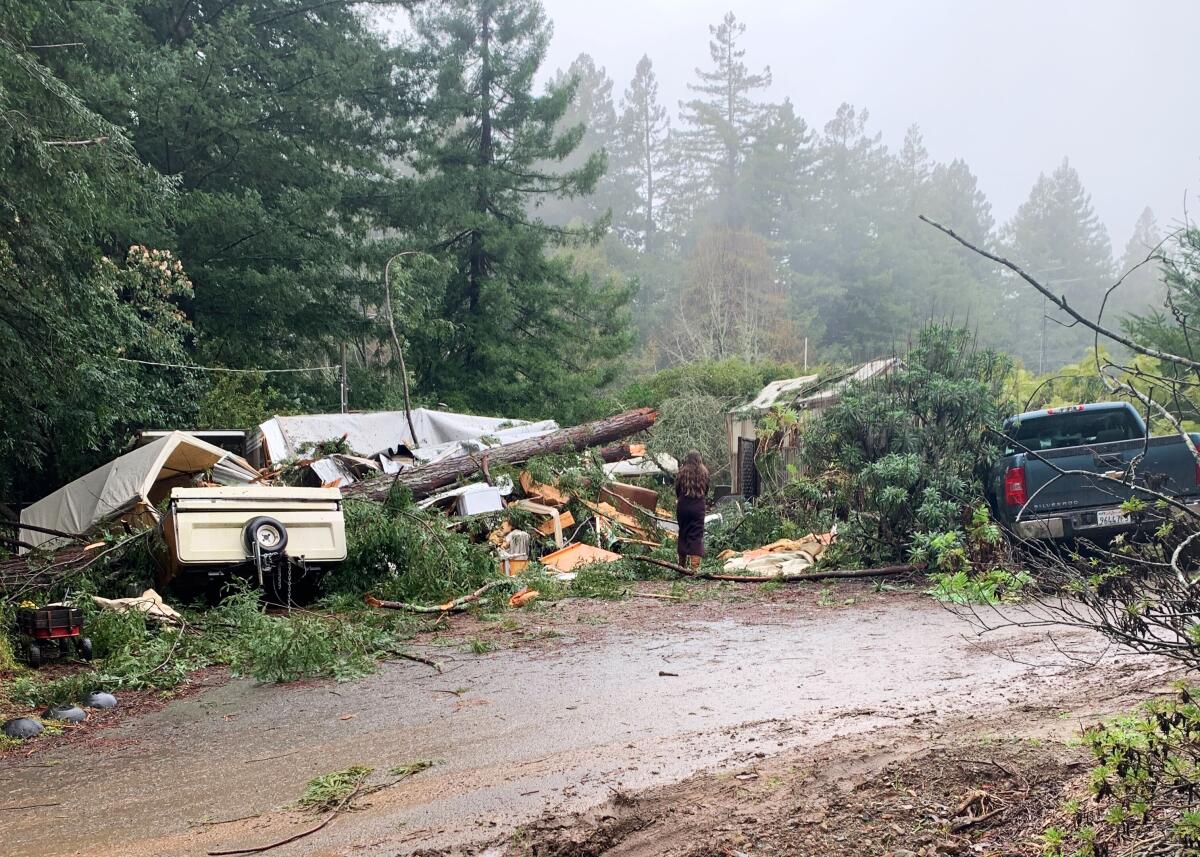
Sonoma County issued an evacuation warning for residents living near the Russian River, including those in Guerneville, Monte Rio, Rio Nido and downstream of Healdsburg.
As the rain stopped Thursday, nearly a dozen people came to the bridge over the river in Monte Rio to marvel at the rushing water, which whisked large trees and an overturned boat past onlookers.
Forecasters no longer project that the river in Guerneville will flood Friday, as it is now expected to peak in the morning at 26.2 feet, below the flood stage level of 32 feet. But the danger has not passed as water levels could rise beyond flood stage Sunday night, following the arrival of weekend rains and as runoff continues to pour into rivers, creeks and streams.
The Hopland area of the Russian River had exceeded flood stage as of Thursday morning, said Brett Whitin, a hydrologist at the California Nevada River Forecast Center.
“It’s not as high as it was in the New Year’s Eve flood,” Whitin said. “It’s a lower-level type of flooding going on there.”
He said the forecast center is anticipating more severe flooding during the upcoming storms through the weekend and next week.
“The Sacramento River will definitely see some flood stages exceeded,” Whitin said. “The Cosumnes River that had the levee breaks, that could see flood stage again next week. There’s that threat of exceeding flood stages at quite a few locations across the northern coast and the Sacramento Valley system.”
In San Jose, authorities have been closely watching possible flooding that could affect populated areas, including along Ross Creek at Cherry Avenue, Upper Penitencia Creek at Mabury and King roads, and Guadalupe River at West Alma Avenue. Elsewhere in Santa Clara County, officials ended evacuation warnings around the Pacheco Pass River Basin and Uvas Reservoir.
Evacuation warnings were canceled in northern San Benito County, where officials had been concerned about a full Pacheco Reservoir spilling floodwaters beyond its dam into the already full Pacheco Creek downstream. A flood could have threatened businesses and homes in a largely agricultural area southeast of Gilroy, alongside Highway 152, a key road that connects the San Francisco Bay Area to Interstate 5. Pacheco Creek peaked and receded without causing damage, officials said.
In Monterey County, officials Thursday expressed concern about the impact of another severe high tide overnight. Evacuation orders or warnings remained in place for some homes near the Carmel River Lagoon and the coastal Yankee Point community, south of Carmel. One home at Yankee Point was damaged by a giant wave, according to local news outlets.
An “extremely large rogue wave” damaged a home in Cambria in San Luis Obispo County, shattering waterfront windows and knocking over a resident, firefighters said. The resident was expected to fully recover.
Summer Lin reported from Sacramento, Rust from Santa Cruz, Garrison from Sonoma County, Rong-Gong Lin II from San Francisco and Fry from Los Angeles. Staff writers Terry Castleman, Grace Toohey, Alexandra E. Petri and Christian Martinez contributed to this story.
More to Read
Sign up for Essential California
The most important California stories and recommendations in your inbox every morning.
You may occasionally receive promotional content from the Los Angeles Times.
